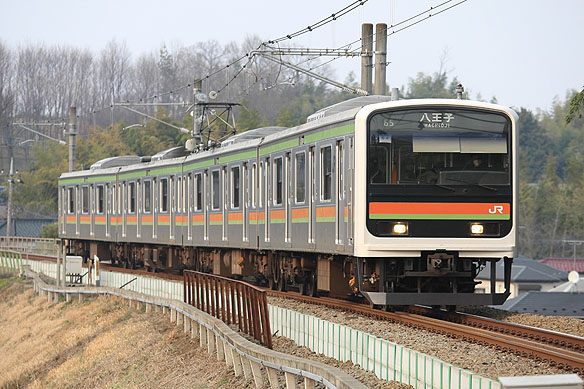Background and overview
JR East developed DC electric multiple unit (EMU) commuter trains classified into 209-3000 series for the start of electrified Hachiko line between Komagawa and Hachioji. Four 4-car sets consisting 2 powered vehicles and 2 trailer vehicles were delivered in 1996.
Car body
They have 2800mm wide body, incorporating unpainted bead-less light weight
stainless construction. The construction of the body is varied depending
on the manufacturer. Vehicles built by Tokyu Car Corporation are constructed
with the outside sheets and inner beams as usual with introducing some
improvements. Vehicles built by Kawasaki Heavy Industries are employed
"two-sheet construction method" that the pressed stainless sheet
and the outside sheet are combined together and those sheets themselves
keep the strength. They have yellowish green and orange coloured waistline
and headline bands running the length of each car below and above the windows.
Cab ends are covered with a Fiber Reinforced Plastics (FRP) painted in
white and black. Anti-fall plates between vehicles are also introduced
excepting the cab end. They are equipped with four 1300mm wide double-leaf
automatic sliding doors on each side of the vehicles. These doors can be
operated manually by pushing the button fitted beside the door. Fixed windows
adopting heat absorbent double-glazing glass are fitted between doors and
drop windows are fitted at the both ends of the body. Door operating equipments,
TKE150, featuring electric screw drive are fitted above the door header
of the sliding doors. Traditional destination rollsigns are fitted on the
side of their body. An air conditioner, AU720A, rated at 42,000kcal/h,
is fitted on the centre of their roof. No ventilators are fitted on the
roof.
Bogies
The 209 series are equipped with DT61 bogies on the powered vehicles and
TR246 bogies on the trailers, featuring bolster-less secondary air suspension,
trailing arm link journal box supporting system, and the single link traction
device. Twin Disc (TD) flexible joint employing deflecting plates made
of carbon-fiber reinforced plastic (CFRP) is applied for power transmission
device. Their brake rigging is a single tread brake for powered and both
directly the single disk and the single tread brake for trailer.
Traction unit and ancillary equipments
Class moha209-3000 vehicles are equipped with 3-step Variable-frequency drive (VFD) traction system, SC41A, which controls 8 traction motors, MT68, with a power output of 95kW on vehicle basis including class moha208-3000 vehicles. This traction system features modular-unit low withstand voltage Gate Turn Off (GTO) thyristor. Class moha208-3000 powered intermediate vehicles are equipped with an auxiliary power unit, SC37A with a power output of 210kVA featuring GTO thyristor under their floor. Class moha209-3000 powered intermediate vehicles are equipped with a compact diamond-shaped current pickup, PS28A, on their roof. Class moha208-3000 powered intermediate vehicles are equipped with a motor driven screw air compressor, MH3096-C1600S under their floor. 209-3000 series employ the electric commanding brake with regenerative brake, featuring brake control of trailer priority. The end cars are equipped with the ATS-P, and ATS-SN signaling systems, and also equipped with emergency brake device and emergency train ptotection device under their floor.
Accommodation
Passenger accommodation consists of longitudinal bench seating featuring
cantilever construction throughout, with an individual seat width of 450
mm per person. Handrails are fitted at the both end and middle of seats.
End vehicles are equipped with a wheelchair/stroller space. A LED display
for providing passenger information, and a door chime are fitted above
the door header of the sliding doors. Roller blinds are gotten rid of by
introducing heat absorbent windowpane.
Operations
They entered rural revenue services of Hachiko lines in March, 1996. However, 209-3000 series train sets began to be displaced with 209-3500 series and E231-3000 series and eventually were completely withdrawn in March, 2020. |
|

